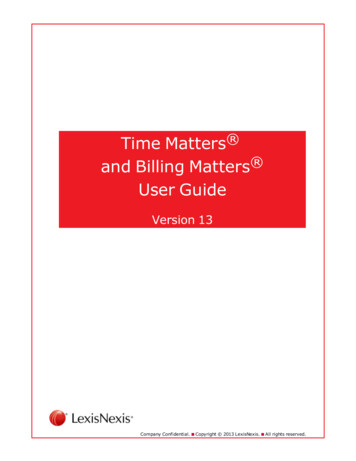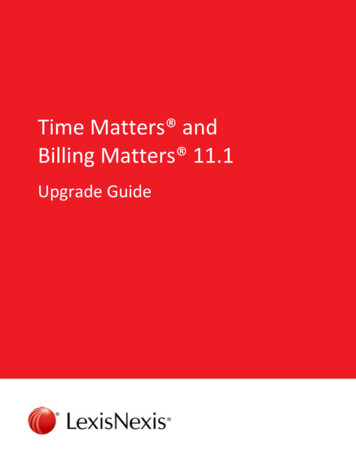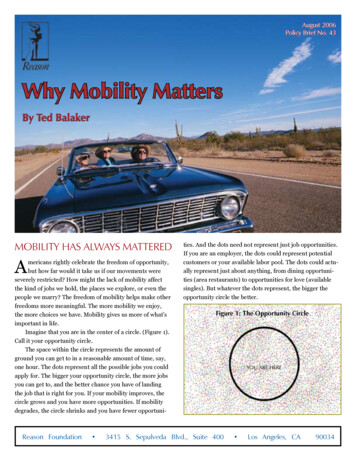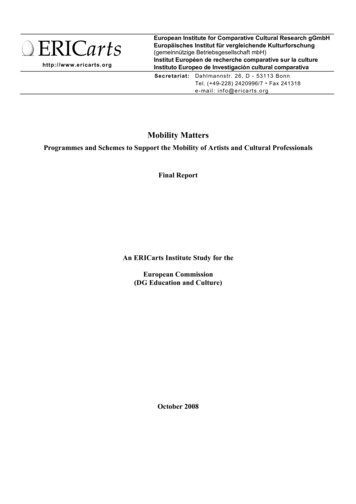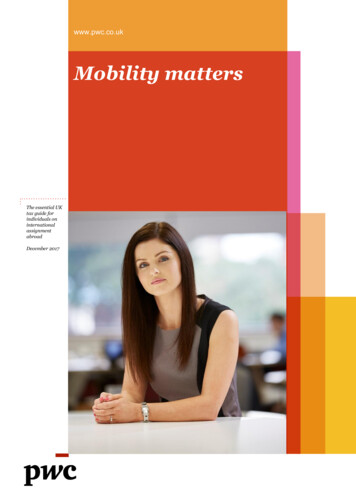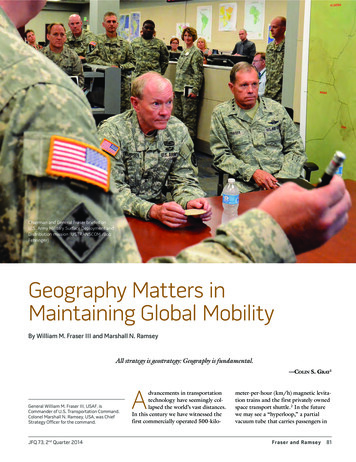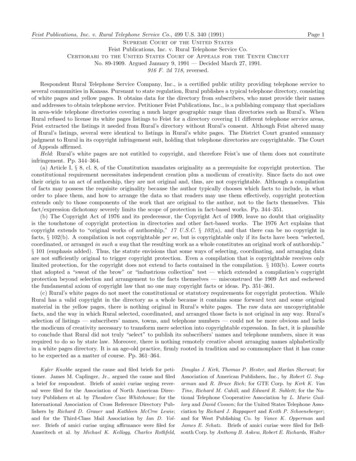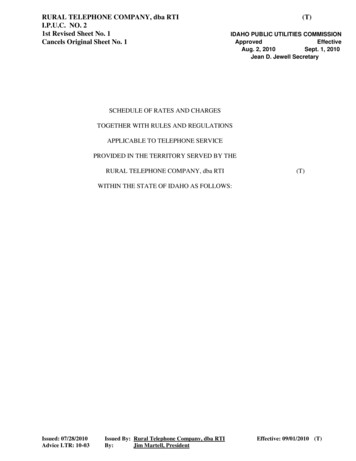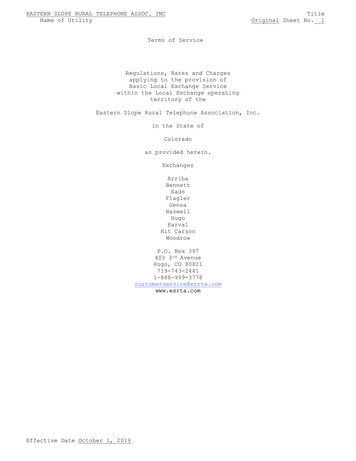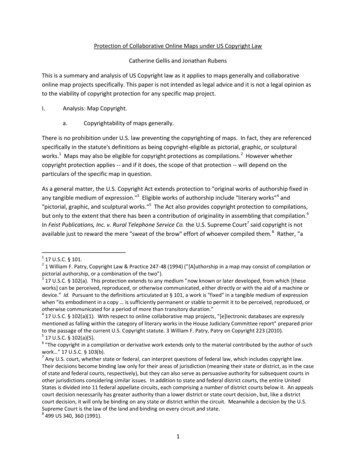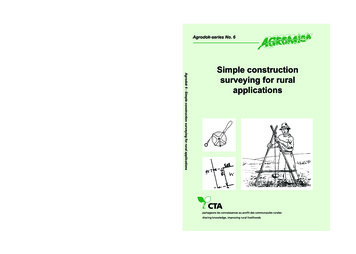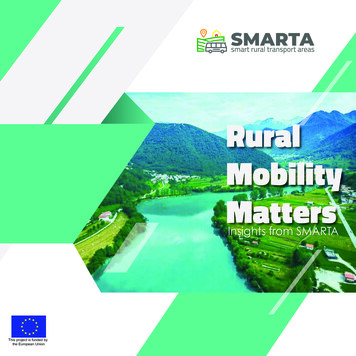
Transcription
RuralMobilityMattersInsights from SMARTAThis project is funded bythe European Union
SMARTASustainable Shared Mobility Interconnected withPublic Transport in European Rural Areas (Developingthe Concept of “SMArt Rural Transport Areas”)Rural Mobility Matters: Insights from SMARTAEditing and design:European Integrated ProjectsAuthors:SMARTA consortiumMemEx SRL (lead partner), Vectos GmbH, The UniversityCourt of the University of Aberdeen, Transport & MobilityLeuven NV, and European Integrated ProjectsSMARTA project at:www.ruralsharedmobility.euThe information and views set out in this report are those of the author(s)and do not necessarily reflect the official opinion of the Commission. TheCommission does not guarantee the accuracy of the data included in thisstudy. Neither the Commission nor any person acting on the Commission’sbehalf may be held responsible for the use which may be made of theinformation contained therein.
Rural Mobility MattersInsights from SMARTASustainable Shared Mobility Interconnectedwith Public Transport in European Rural Areas(Developing the Concept of “SMArt Rural Transport Areas”)This project is funded bythe European Union
THE SMARTA PROJECT IN A NUTSHELLThe SMARTA project has been one of themost interesting initiatives set up by theEuropean Union for rural mobility. Theproject has sought to understand the role,relevance, and potential of demand-responsive and shared mobility services, integrated with public transport, in Europeanrural areas.What is SMARTA about?The SMARTA project has focused on ruralmobility and, in particular, on rural sharedmobility. Rural public transport services inEurope are under stress, due to a combination of factors, including austerity measures, demographic change, and poor connectivity in terms of infrastructure.The absence of diverse mobility serviceshas resulted in rural areas that havebecome highly auto dependent. The inevitable outcome is that those without cars aredependent on others for lifts, often meaning they have reduced possibilities to participate in society. Since its beginning in 2018,the SMARTA project has focused on how toexploit existing mobility policies and solutions in European rural areas and exploreways to support sustainable shared mobility, interconnected with public transport.
SMARTA’S AMBITIONThe project has aimed to give reliable guidance to policy makers, local authorities, andpractitioners to develop suitable policies and efficient operational solutions for rural mobility. This would enable them to:Develop a new vision for rural mobility at national, regional, and local levels;Define specific and measurable targets for rural mobility;Work in a dedicated evaluation framework for rural mobility;Assign dedicated responsibilities and obligations for achievementof the identified rural mobility targets.
SMARTA’S STREAMS OF ACTIVITIESAn analysis of rural mobility at EU levelSMARTA provided the opportunity for a comprehensive analysis of the challenges of mobility in rural areas, including the market and the policy context in all ofthe EU-28 countries (plus selected EEA states, North America, and Australia). Theproject consortium has profiled for each country the framework (institutional,regulatory, organisational, financial, etc.) within which shared mobility services inrural areas sit and related policies (at national or regional level). This sets out afactual mapping of the current situation, which had not been done before.Improving the knowledge on sustainable rural mobilityResearch was done in order to identify current and emerging good practices andtheir level of innovation was appraised. In parallel, SMARTA has engaged with anumber of pilot sites implementing rural shared mobility solutions. Pilot activities provide the opportunity to examine the effectiveness, efficiency, impacts,and future prospects for something new, improved, or extended. The aim was togain a deep understanding about the key findings, lessons learnt, and transferability issues of different mobility solutions.Raising awareness on rural mobilityOne of the key activities of SMARTA consisted of engagement with relevant stakeholders active in the field of rural mobility. Positive links have been developedwith other projects related to rural mobility and accessibility, as well as with relevant initiatives or organisations. The SMARTA stakeholder network was instrumental in ensuring the validation of the project’s activities, for achieving widespread uptake of the SMARTA findings and for raising awareness about the ruralmobility issues. Additionally, a number of dissemination and communicationinstruments have been developed, including leaflets, brochures, a rich website,and very active social media.
SMARTA PROJECT’S STAGESTIME TO RETHINK RURAL MOBILITYIdentifying the rural mobility problem(s)Understanding the existing frameworks and policiesEstablish a network of rural mobility stakeholdersfrom all over EuropeTIME TO ACT FOR RURAL MOBILITYMapping the existing solutions and their innovationcomponentStudying good practice examples and understandingwhat makes them successfulSelecting pilot sites, to monitor and test shared ruralmobility solutionsClosely collaborate with stakeholders from all overEurope in understanding the feasibility of the solutionsRURAL MOBILITY MATTERSStudying the outcome of shared mobility solutionsimplemented in the pilot sitesAssessing the needs of stakeholders in implementingcomprehensive policy that covers all European ruralareasFormulating policy recommendations
01“The European Green Deal is an opportunity to reshapethe entire transport system, to make it safe, sustainable,affordable, and accessible to all. And this means a newvision for rural areas.” 1 Ciaran Cuffe, MEP (TRAN Committee, European Parliament)TIME TORURALMOBILITYThe quote is from Ciaran Cuffe's intervention during the SMARTA Final Conference, December 2020. You can watch the recording of the conference following this link:https://bit.ly/3bZVUEo1
It is important to address the widespread opinion that inrural areas everyone has a car. This is, for sure, not true.Many people cannot drive, by reason of age, condition, oraffordability. When the household car(s) is in use, otherhousehold members do not have access to it. Low-incomehouseholds and individuals may not have a car. In theabsence of good public transport or shared mobilityservices, many people can’t get around. This serious gaplimits their participation in society, their earning potential,and their contribution to the economy. In addition to thehuman cost, many will inevitably leave, putting even morepressure on the remaining facilities in a village or rural area.A NUMBER OFCONSIDERATIONSEMERGED:The rural mobility problem is not one, but many. Differentissues covering transport provision were identified: limitedaccess and connectivity, longer distances, lack of publictransport and/or alternatives to private cars, and lack offinancing for mobility schemes. The specific rural land-usepatterns (urban sprawl, scattered regions, lack of territorialplanning for rural areas) are an important factor that leadsto a high degree of car dependency in rural populationsand, together with the poor infrastructure and lack ofpublic transport provision, lead to limited accessibility andconnectivity. The lack of accessibility translates into a lack of(physical) access to all kinds of services. These services areseen to be much broader than mobility services andencompass public services like postal services, healthservices, but also services like shops, grocery, pharmacy,barber, pubs, and others.The Time to Rethink RuralMobility stage of theSMARTA project aimed atidentifying the specificchallenges of rural mobilityand at understanding theexisting frameworks forrural policies across the EUcountries.
There are real differences across types ofrural areas, regions, Member States. In somelocations, rural areas can be characterisedby the presence of high-income people,while in other rural areas there could be alarge presence of poor households. Mountainous regions are very different fromcoastal areas. For some areas, it is the sheerremoteness itself which is the cause of theproblem. In others, there are topographicalchallenges, a need for conservation, or seasonality issues, e.g. due to tourism. Thisdiversity is making it difficult for one modelto work in all areas.Everybody living in rural areas is impacted,directly or indirectly, by the deficits in ruralmobility. But there are a number of vulnerable categories that are more impacted: theelderly, the disabled, low-income families orthe unemployed, single parents, teenagers,immigrants, newcomers to the area, peoplewho are confronted with a sudden crisis.Deficits in rural mobility inhibit other strategies for rural areas and regions. The mainelements which are inhibited by the lack ofrural mobility are certainly the life and the(economic) development of local society andlocal communities. Strategies in other sectors (e.g. social and health services) oftenignore the need for transport, which canlimit their effectiveness if there is insufficienttransport available. Businesses need to havetransport options available in order toattract potential employees. Too much carmobility for people in the rural area resultsin disappearing services, as car mobilityenables people to use services that are relatively far way.A policy framework for rural mobility, in thesense of a framework that specifically recognises and is designed for mobility in ruralareas, is lacking in most EU-28 MemberStates. In countries or regions where institutional, regulatory, and financial frameworksare well developed, they tend to be moreurban-focussed and prioritise big infrastructure projects and urban projects over ruraltransport.Legislative frameworks often inhibit innovation in rural mobility, whereas they shouldsupport local initiatives and empower localcommunities to make changes and find solutions. For example, the way public transportis regulated in many countries excludesshared solutions or on-demand services.
THE NEED FORA NEW VISIONMapping the existing frameworks and practices across all EU-28 countries resulted in aneed to rethink rural mobility. There is aclear need for a new vision and a newsetting for rural mobility policies in order toimprove rural mobility and to bringlong-term benefits.Ideally, there should be policy frameworkchanges at a high level in order to have a bigimpact and, in order to do this, there is aneed for these changes to be politicallyattractive, since politicians would need to beable to see the benefit for them to getinvolved.Rural mobility should be prioritised toenable initiatives to take place; this wouldgive direction and provide motivation atnational and local levels, with the implementation being handled at a national or sub-national level.KEY MESSAGE:There is a clear need for a new visionand a new setting for rural mobilitypolicies.
Read the first SMARTA brochure for a detailed description of thefindings in the first stage of the project:https://bit.ly/3cR2lIT
02“SMARTA has helped us to strengthen our expertise, or todevelop expertise, as we need it to understand how effectivemobility services could be offered for rural areas. And theproject has demonstrated successful mobility schemes. [.]It has also helped us to get a better view on existing regionaland national policy frameworks.” 2 Isabelle Vandoorne (DGMOVE, European Commission)The quote is from Isabelle Vandoorne's intervention during the SMARTA Final Conference, December 2020. You can watch the recording of the conference following this link:https://bit.ly/38WKWh82
Village Bus inKolsillre, SECommunityTransportation Program– Ontario, CDNNational Maas Framework, FIITNAmerica – CommunityBased Rural & TownTransportation, USABadenoch and StrathspeyCommunity TransportCompany – Scotland, UKFare-free buses,EEDonegal LocalLink, IERural Transport Program, IESuffolk LinksDRT, UKTexelhopper, NLMuldental in Fahrt, DENorthern Commute, IERing a Link, Kilkenny, IERegioTaxi, NLTalybont Energy –Wales, UKFlexi Tec, BEBürgerbus,DEKrakow Metropolitan Transport, PLAV - Bad Birnbach, DESmart Move – MetropolitanArea of Alba Iulia, RomaniaGo-Mobil, ATBummelbus, LUAlpine Bus, CHSopotiniki, SIRezopouce, FRFast seasonal bus line –Varna, BGProntobus DRT,Modena, ITRural DRT - Castilla y Leon, ESEcoVolis, ALShared Use MobilityAgency – Elba Island, ITDRT in the region ofMiddle Tejo, PTShotl Platform, ESSmartMove EU Project, ELFigure 1: SMARTA’s map of good practices and demonstratorsWestern Region DRTPilot Stage 1 – NewSouth Wales, AUSSOURCE: SMARTA PROJECTSMARTA set out to increase the knowledge on sustainable rural mobility by identifying and evaluating shared mobility solutions implemented or under implementation in rural areas acrossEurope, analysing the enablers and barriers for widespread deployment of rural shared mobility solutions, as well as assessing the transferability potential of rural shared mobility solutions.A significant number of Good Practices have been identified, covering different countries across Europe and beyond, as shown in the figure below.
A WEALTH OF MOBILITY SOLUTIONSIs fixed-route public transport by bus the onlyway to offer transport solutions to ruralpeople?The wealth of good practices identifiedshows that there is a great diversity of solutions and ways of providing public transport,contextually adjusted to the specifics of theterritories and the needs of the residents.Flexible transport services with minibuses,door-to-door DRT with “virtual” stops,shared taxis, and car pooling are only a partof the many solutions that can improve mobility for people in rural areas.3A mobility service usually consists of the“physical” service plus the provision of “virtual” services which ease access to them. Thephysical services can be classified using themobility modes: conventional public transport, flexible collective transport, and sharedservices (ride sharing or asset sharing). Thefigure below offers a clustering of suchservices. The virtual services might includeplatforms for the booking and reservation,travel service info, ticketing (B2C Services)and back-office service such as monitoring,planning, tracking and tracing, etc.Flexibleroute DRTDoor-to-INRASHECar poolingRIDE-hitchhickingVolunteerliftgivingSOURCE: SMARTA PROJECTSharedtaxiFixed-routebus and railGCarsharingASSET SHARIGdoor DRTFLEXIBLE TRANSPORTSESICERVNE-bikesharingFigure 2: The array of rural shared mobility services identified3This brochure only presents a number of the solutions identified and researched, as a way of exemplification. All good practices reports can be consulted here:https://bit.ly/3ltW4XM and descriptions of the SMARTA or SMARTA 2 demonstrators here: https://bit.ly/30W09un
FLEXIBLE TRANSPORT SERVICESDemand-Responsive Transport (DRT) areservices scheduled to pick up and drop offpeople in accordance with the actual needsof the passengers. It may take the form offlexible routes or door-to-door DRT. Thesetypes of services are best viewed as a rangeof intermediate transport solutions thatspan the wide space between taxi and publictransport.Over the last two decades, there have beenmany implementations of DRTs in ruralareas, of different types and in different contexts. This indicates that DRT could be theprimary model for rural shared mobility,especially if it is well coordinated with theregular public transport network servingtowns and inter-urban corridors.The ability of DRT to provide efficient andaffordable transport services has been greatly enhanced by the use of technology. Forexample, routes can be fully dynamic andadjusted in real time, based on traffic anddemand, thanks to advanced algorithms ofthe software that ensure the maximum punctuality on every ride. Services are also moreattractive, especially for young people, thanksto the possibility to book a trip via mobile app.And reservation can be made up to 10 or 15minutes in advance. New organisationalstructures and business models have evolvedfor better delivery of these services.Despite its effectiveness in rural settings andits high potential, to date DRT has not beenextensively deployed in Europe as a complementary public transport service. The mostcommon type of DRT is the services dedicatedto vulnerable users, such as elderly anddisabled people. These services follow socialobjectives, in particular to combat socialexclusion, and are highly appreciated by theiruser base. However, they often functionas a“safety net” rather than seeking to providecomprehensive mobility for all of the population in the rural areas.
ON-DEMAND POOLING SERVICES IN THELOW-DEMAND AREAS OF CATALONIA,SPAINOn-demand pooling transport services havebeen introduced in 2017-2018 in the municipalities of Sant Cugat del Vallès and Vallirana, in the surrounding area of the Barcelonaconurbation. The services cover low-demand peripheral areas of both municipalities. The service is operated by minivans andbus stops are used for pick-up and drop-off.The services were designed as replacementof former ineffective regular services andthey were implemented introducing thepooling technological platform Shotl, anintegrated platform supporting the management of flexible services and providing valuable services for all the stakeholder (PToperator, PT authority, customers) throughdedicated interfaces. Machine learning algorithms are used for the optimisation of thescheduling compared to the request and thetraffic information.Detailed info here: https://bit.ly/30ZcxtGCOLLABORATIVE REGIONAL TAXI SERVICES – REGIOTAXI, NETHERLANDSRegiotaxi is essentially a regional taxi servicethat operates in several regions in the Netherlands. The service is primarily adoor-to-door service that picks up a userfrom an origin point (e.g. home) and takesthem to their destination. The system has nofixed stops or routes. Other travellers mayalso be picked up en route, which meansthat Regiotaxi is able to charge lower pricesthan conventional taxi competitors.Regiotaxi is a collaborative arrangementbetween several municipalities that recognisethat gaps in existing public transport serviceshave consequent effects on the mobility oflocal people, including those in rural areas.The service is geared particularly towardsthose with limited public transport accessibility and disabled people. For municipalities, it ismore expensive than the provision of conventional mass transit services.Detailed info here: https://bit.ly/3s2em4U
DRT SERVICES TO ADDRESS SOCIAL EXCLUSION – RING A LINK, IRELANDEstablished in 2001 as a grassroots organisation of local transport services focusing oncombatting social exclusion, Ring a Linkcurrently operates daily and regular DRT andscheduled services and it has expanded itscoverage area. The service has now developed into a comprehensive transport coordination unit with operations in five Irishcounties. It directly operates 23 minibusesand contracts in a further 10 minibusesdaily. Ring a Link provides primarily minibus-based DRT services and somefixed-route services. All services are for general use, but the DRT services require to bepre-booked.DRT services are timed to meet with scheduled/fixed-route services. Some services aredesigned as feeders to longer-distanceroutes.The vision for Ring a Link adopted in September 2017 states: “We aspire to provide qualityrural services that link our service users toessential services, supports and people intheir communities. We strive to reduce isolation for the dispersed rural individuals weserve through facilitating participation andconnection with communities.”Detailed info here: https://bit.ly/310cH3KDRT INTEGRATED WITH CONVENTIONAL PUBLICTRANSPORT – TRANSPORTE A PEDIDO, PORTUGALThis DRT service is operated by taxis andintegrated with the conventional PT servicesto serve dispersed demand in the peripheral/rural area and small villages in the regionof Middle Tejo. The DRT services have beenintroduced to integrate
RURAL MOBILITY MATTERS Studying the outcome of shared mobility solutions . TIME TO RURAL MOBILITY “The European Green Deal an opportunity to reshape is the entire transport system, to make it safe, sustainable, affordable, and accessible to all. And this means a new
